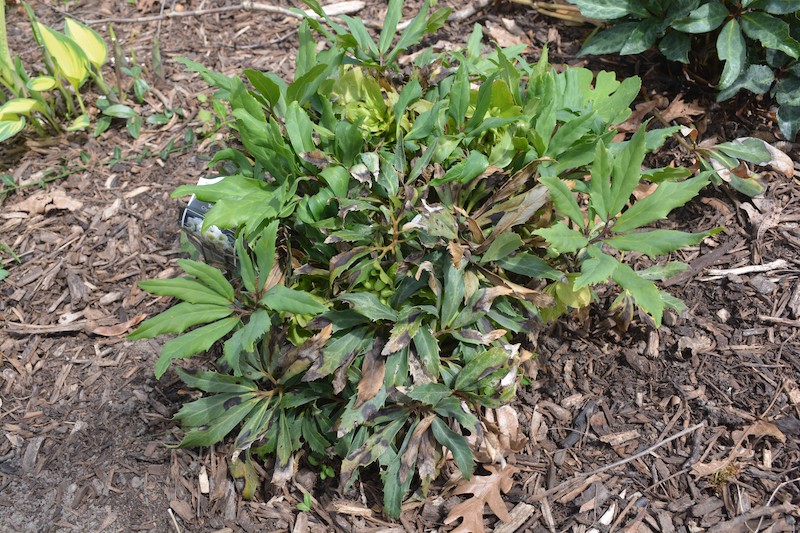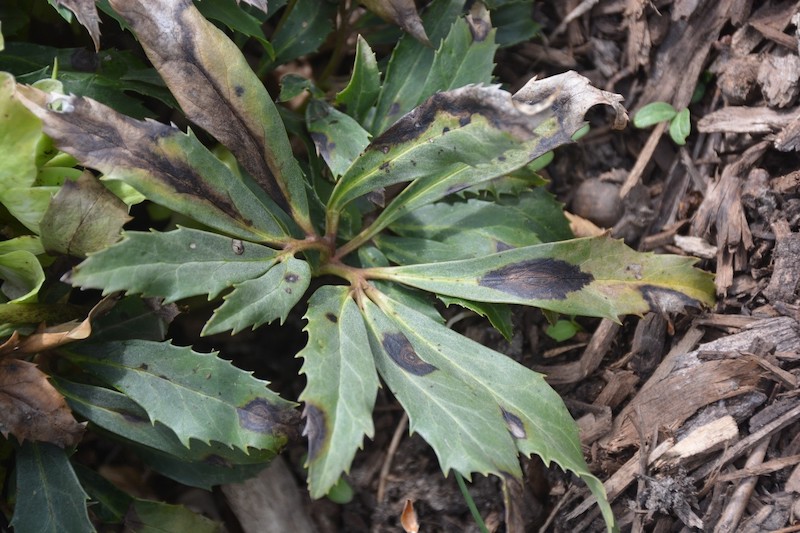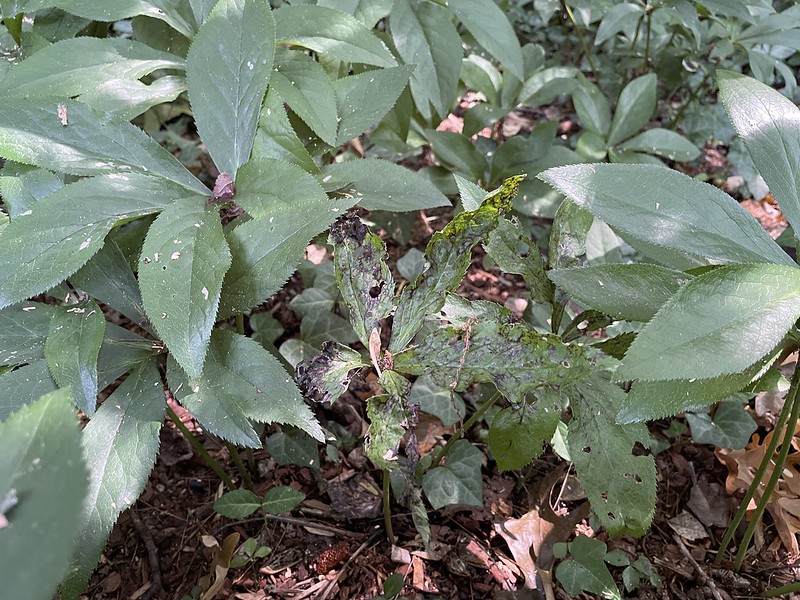Hellebores, or Lenten roses, are typically not bothered by many diseases in the home landscape. Fungal pathogens present the most common disease challenges to this plant. The damp, cool conditions of spring and fall, in particular, favor the development of diseases like black spot, botrytis blight, and downy mildew that can impact the appearance and health of the plant. On occasion, a viral disease transmitted by aphids can infect hellebores. Although uncommon, this virus warrants the destruction of infected plants to stop its spread.

Black Spot
Black spot on hellebores is a fungal disease that appears on hellebores in late winter into early spring. Caused by the pathogen Microsphaeropsis hellebori, it can appear on various hellebore species and is often mistaken for winter injury, as it appears around the same time.
Identifying Black Spot
As the disease name suggests, dark spots appear on leaf blades and margins. Spots are ringed and can enlarge and merge, developing small black fruiting bodies within the spots. Spots also appear on flower buds and can cause wilt, rot, and failure to open.

Photo courtesy of Travis Cleveland, University of Illinois
Treating Black Spot
Black spot spreads via spores in splashing water and favors damp, cool conditions. Avoid overhead irrigation, remove and destroy infected leaves, and clean pruning tools between plants. A fungicide labeled for black spot may offer control, but likely is only warranted in highly visible areas and when extended cool, wet weather is occurring.
Downy Mildew
Downy mildew, like other fungal diseases, becomes established and spreads most rapidly when conditions are damp and cool, as in spring. This disease affects foliage, making it unsightly and affecting overall plant health.
Identifying Downy Mildew
Downy mildew appears on hellebore as a white or gray powdery coating on leaves. The infection will develop into yellow spots on the leaves. A severe infection will seriously impact plant health and appearance.
Treating Downy Mildew
Proper spacing is critical to avoiding downy mildew and other diseases. Prune out infected foliage as it appears and remove debris from the area. Only water the hellebore at the root zone to avoid splashing the foliage. Where downy mildew has presented issues in the past, consider applying a preventative fungicide to the hellebore early in the year, about two weeks before the downy mildew typically appears.
Crown, Stem, or Root Rot
Established hellebores have relatively low water needs, so particularly damp weather, overwatering, poor drainage, or damage to the crown of the hellebore can leave it vulnerable to a fungal disease that causes crown rot. Various fungal pathogens can attack a vulnerable hellebore.
Identifying Crown, Stem, or Root Rot
Rots are often first noticed when an otherwise healthy-looking stem falls over at the base for no apparent reason. Upon closer inspection, brownish or black rotten spots will be present at the point of collapse. To confirm root or rhizome rot, dig up and inspect the roots, which will be soft and mushy if a disease is present.
Treating Crown, Stem, or Root Rot
Remove and dispose of all infected plant material. Make sure mulch is slightly pulled back from the base of the plant. An excessively low soil pH and too much moisture around the base or roots of the plant can lead to rot issues. In many situations, the best course of action may be to transplant affected hellebores to sites with better soil conditions.
Botrytis Blight
Botrytis blight, also known as gray mold, develops rapidly when conditions are moist or humid and temperatures are moderate. This fungus is easy to identify and most easily managed by addressing moisture in the landscape.
Identifying Botrytis Blight
Botrytis first appears as small, water-soaked spots that turn brown. Grayish fungal spores develop on decaying tissue and give the infection a fuzzy appearance.
Treating Botrytis Blight
Remove infected plant parts as soon as they are noticed and destroy them. Maintain a tidy garden space by pulling weeds and removing fallen leaves. Avoid splashing water on the plants and improve air circulation around hellebores, if possible. If botrytis has been a significant issue in the past and conditions favor fungal diseases, chemical control may be warranted. To be effective, make note of when the disease first appeared in a year, and then in subsequent years, time a fungicide application for two weeks prior to the anticipated disease appearance.
Black Death
There is a virus that can affect hellebores. It is fairly uncommon and known as Hellebore Net Necrosis Virus (HeNNV). It is far more likely to occur in large-scale growing operations, so carefully inspecting plants before purchase is the best way to avoid this disease in the home landscape.
Identifying Black Death
Black death appears on mature hellebores as black streaks or blotches on leaves and flower bracts. It can also cause stunted growth, dark spots, and dark leaf veins. The presence of aphids may also be a giveaway, as these pests are a vector for the virus.

Photo courtesy of Matt Borden, unmodified, Flickr, Copyright CC By-SA 2.0
Treating Black Death
There is no hope for saving black death-infected hellebores. Instead, try to keep the disease from spreading by digging up and destroying infected plants. Sanitize pruning shears and other tools after handling infected plants.
Hellebore Disease Chart
|
Disease |
Identifying |
Treating |
|
Black Spot |
Dark spots on leaves |
Proper air circulation, avoid overhead watering |
|
Downy Mildew |
White coating and yellow spots |
Proper Air Circulation, remove affected foliage, apply fungicide in severe cases |
|
Crown, Stem, Root Rots |
Shoots collapsing, rotten spots |
Improve soil drainage |
|
Botrytis Blight |
Water-soaked spots, gray fuzzy spores |
Proper air circulation, good garden hygiene |
|
Black Death |
Black blotches and streaks |
Destroy infected plants |
Sources: "What is black death of hellebores (hellebore net necrosis virus)?" New York Botanical Garden. libanswers.nybg.org"
 |
Author Angela Ryczkowski - Published 7-15-2023 |
